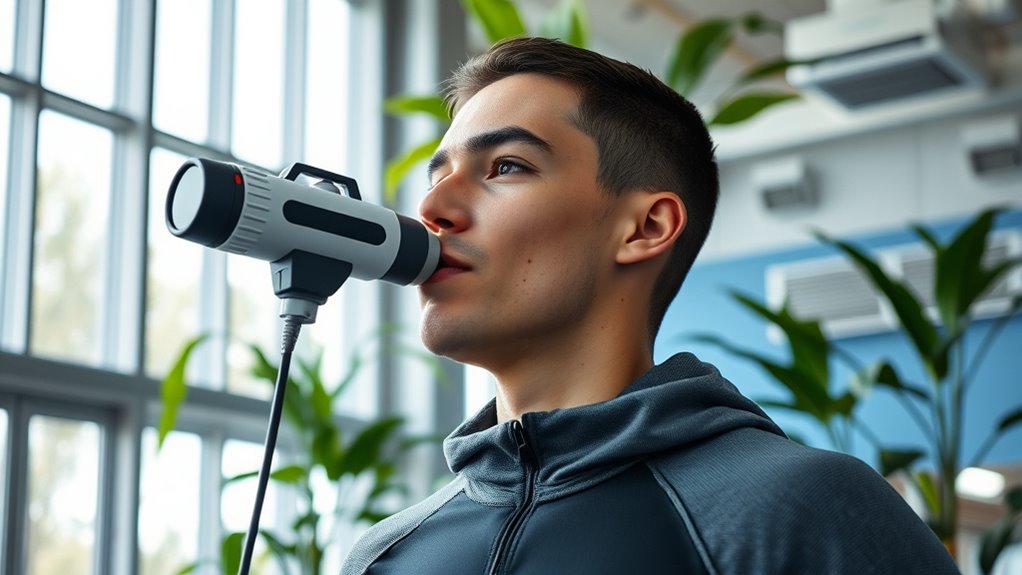To optimize indoor air for your respiratory health, focus on improving air quality with high-efficiency filters like HEPA to remove pollutants, dust, and allergens. Incorporate breathing exercises to strengthen your lungs and increase capacity. Combining clean air with targeted breathing techniques reduces irritation and boosts your endurance. Maintaining this balance supports your recovery and athletic performance. Keep exploring ways to enhance your respiratory health to stay at your best during training and competitions.
Key Takeaways
- Use high-efficiency air filters like HEPA to remove airborne pollutants and improve indoor air quality.
- Incorporate breathing exercises to strengthen respiratory muscles and enhance lung capacity.
- Regularly replace or upgrade indoor air filtration systems to maintain clean, healthy breathing environments.
- Minimize indoor allergens and pollutants through proper ventilation and air purification practices.
- Combine clean air with targeted breathing techniques to boost respiratory resilience and athletic performance.

Maintaining good respiratory health is vital for athletes because your lungs play a critical role in delivering oxygen to your muscles during exercise. When indoor air quality is compromised, it can hinder your performance and recovery. One effective way to improve indoor air quality is through proper air filtration. High-efficiency air filters, such as HEPA filters, help remove airborne particles like dust, pollen, mold spores, and other pollutants that can irritate your respiratory system. Regularly replacing or upgrading your air filters guarantees that the air you breathe remains clean, reducing the risk of respiratory issues that could impair your training. Good air filtration doesn’t just benefit your lungs; it also creates a healthier environment overall, making it easier to focus and train consistently.
In addition to filtering the air, incorporating breathing exercises into your routine can markedly enhance your respiratory capacity. Breathing exercises, such as diaphragmatic breathing or pursed-lip breathing, help strengthen your respiratory muscles and improve lung efficiency. When you practice these exercises regularly, you increase lung capacity and promote better oxygen exchange, which is vital during intense workouts. They also help reduce stress and anxiety, which can negatively impact your breathing pattern and athletic performance. By focusing on deep, controlled breaths, you train your body to utilize oxygen more effectively, leading to improved stamina and quicker recovery times. These exercises are simple to perform and can be integrated into your daily routine, whether during warm-ups, cool-downs, or even during breaks in training. Additionally, understanding the importance of air filtration technology can further motivate you to maintain a clean indoor environment.
Combining effective air filtration with consistent breathing exercises creates a powerful synergy for optimizing your indoor respiratory health. Clean air reduces the chances of respiratory irritation caused by allergens or pollutants, while targeted breathing techniques strengthen your lungs and improve overall breathing efficiency. This dual approach guarantees that your respiratory system remains resilient against indoor air quality issues, providing a solid foundation for peak athletic performance. Remember, your lungs are your engine—keeping them healthy and efficient directly translates into better endurance, strength, and recovery. By paying attention to indoor air quality through proper filtration and dedicating time to breathing exercises, you set yourself up for long-term respiratory health and athletic success. Staying proactive in these areas makes a tangible difference in how you breathe, perform, and ultimately reach your goals.
Frequently Asked Questions
How Does Humidity Affect Athlete Respiratory Health Indoors?
Humidity levels greatly impact your respiratory comfort indoors. When humidity is too low, the air becomes dry, irritating your airways and increasing susceptibility to respiratory issues. Conversely, high humidity can cause mold growth and dust mites, which may worsen breathing problems. Maintaining ideal humidity levels keeps your respiratory system comfortable, reducing irritation and supporting better airflow during workouts. Proper indoor humidity is essential for your respiratory health and athletic performance.
Are Air Purifiers Effective in Improving Indoor Air Quality for Athletes?
Think of an air purifier as a vigilant guardian, constantly battling airborne pollutants. Yes, they’re effective in improving indoor air quality for athletes. Modern air purifier technology captures dust, pollen, and other irritants, making breathing easier. However, you must maintain filters regularly to keep their performance ideal. When used correctly, air purifiers can considerably reduce respiratory irritants, helping you breathe freely during intense training sessions.
What Are Common Indoor Air Pollutants That Hinder Athletic Performance?
You should be aware that high VOC levels and mold spores are common indoor air pollutants that can hinder your athletic performance. VOCs come from cleaning products, paints, and furnishings, irritating your lungs and causing fatigue. Mold spores thrive in damp environments, leading to respiratory issues like asthma or bronchitis. To optimize your indoor air, guarantee proper ventilation, control humidity, and use air purification methods to reduce these pollutants.
How Often Should Indoor Air Quality Be Monitored in Athletic Facilities?
Imagine the crisp, clean air flowing through your gym, essential for peak performance. You should monitor indoor air quality regularly—at least monthly—to guarantee it meets air quality standards. Consistent checks help identify pollutants early. Follow ventilation protocols diligently, adjusting them as needed. This routine keeps the air fresh, supporting athletes’ respiratory health and maintaining ideal indoor conditions for their training and competitions.
Can Indoor Plants Improve Air Quality for Athletes?
Indoor plants can improve air quality for athletes by providing natural air filtration. Certain plant species, like snake plants or pothos, effectively remove toxins and increase oxygen levels. Incorporate a variety of these plants into your indoor space to create cleaner, fresher air. Regular maintenance and choosing plants suited for indoor environments enhance their air filtration benefits, supporting better respiratory health and athletic performance.
Conclusion
By prioritizing indoor air quality, you can breathe easier and perform at your best—like a fish thriving in clean water. Remember, healthy lungs are the foundation of athletic success, so stay vigilant about ventilation, humidity, and air purity. Small changes make a big difference, helping you avoid respiratory issues and keep your body in peak condition. Take control of your environment, and let fresh air fuel your journey to greatness.









